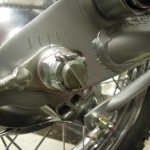I remember exactly where I learned this little tip, from auto mechanics school many years ago. The instructor was very deliberate in ensuring all the students understood how to properly install a cotter pin when used with a castle nut. This has stuck with me for all these years and I’ve used this technique without fail ever since (even though I’m not an auto mechanic).
In this example, note the head of the cotter pin is set parallel to the length of the axle and is actually set down into one of the notches of the castle nut. One leg of the pin is bent back against the flat of the nut, the other is bent up around the end of the axle and pressed tight against the axle end. The ends of the legs are then trimmed, particularly the outside leg, about even with outside edge of the bolt – or axle in this case.
Often the pin is installed rotated 90 degrees from the photo so the head doesn’t settle into the notch in the nut and the pin legs are bent perpendicular to the axis of the axle. Not correct, at least according to my auto mechanics instructor of many years ago.

I still kind of wonder if any true reason exists as to a better or worse direction for the pin to sit in. Both ways stop the castle nut from turning. Both ways remain locked and allow the cover to be reseated..
Short of a full shearing of the pin by some bizarre force.. you think one is really prefferable if in both instances the pin is locking and out of the way?
Interesting post and to respond to your last question… it probably doesn’t really matter. The force required to shear a pin, regardless of how the pin is oriented when installed, would have to be very significant, as you pointed out. The pin is only intended to prevent the accidental backing-off of the nut.
In reality, I believe it’s simply a preference thing and the way I was taught does look more “finished” in my view.
It does matter. It’s not just for shearing a pin. Vibration can cause incorrectly installed pins to fret and break. This sort of thing is more important on aircraft and turbine systems as it can create foreign material issues within a system and could fatally cause a forced outage or system shut down. Correct installation of split pins is important.
And that is why aviation uses wire locking because people make mistakes like this guy’s instructor
The Federal Aviation Authority and The European Aviation Safety Authority allow both radial and axial deformation of the legs when using split pins. Sometimes the axial method (where the legs are bent at 90 degrees to the nut but aligned with the axis of the bolt) is preferred because of ease of fitment in tight areas. The Radial deformation method is sometimes stipulated because of possible conflicts with the split pin end if an axial deformation method is chosen, ie the pin doesnt stick out beyond the bolt so cannot snag on neighbouring moveable parts.
Thank you for the comment, I had never heard this info before.
And it is wrong
Then your instructor was incorrect.
Split pins, as they are correctly known, serve one purpose. To stop a nut from coming off a thread. The legs of a split pin serve a different purpose, they stop the pin falling out of the hole.
There is no reason ever why you would bend around a loose leg and flatten it against a shaft. Did your instructor not discuss lengths, diameters and materials?
You split the legs by moving one of the legs around 30 degrees ONLY to stop it falling out of the hole. This means that when you come to removing it, the pin can be re-used, but essentially, you have made it easy to remove. Bending the legs further than this just causes a bump in the pin that stops it passing through the hole.